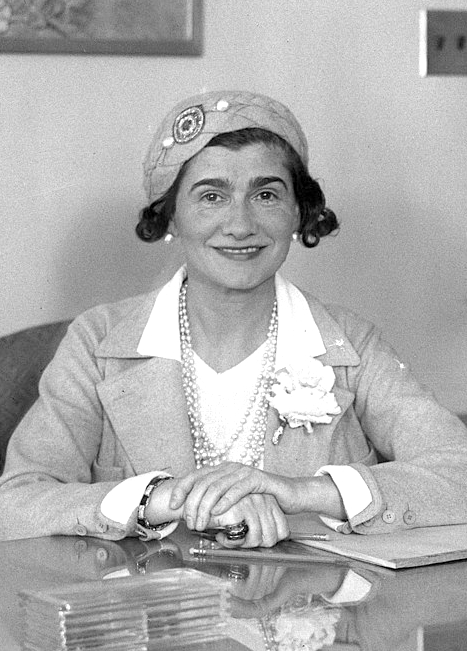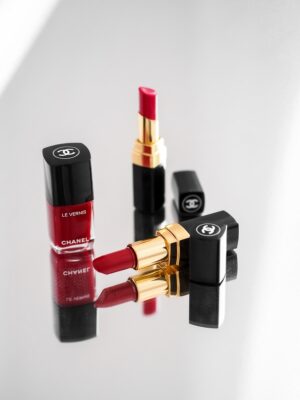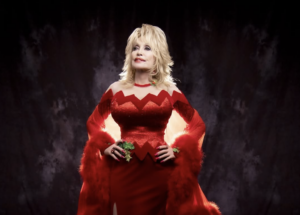When you hear the name Coco Chanel, it immediately conjures up images of elegance, rebellion, and an unwavering confidence that changed the face of fashion forever.
Born Gabrielle Bonheur Chanel in 1883, this little girl from Saumur, France, grew into one of the most influential women of the 20th century, and her legacy continues to shape fashion, beauty, and culture today. Coco didn’t just design clothes—she revolutionized the way women saw themselves, how they dressed, and what they thought they could achieve.
“Beauty begins the moment you decide to be yourself.”
Coco Chanel
As Coco herself said, “In order to be irreplaceable, one must always be different.” And different she was. From her early struggles to the heights of success with the House of Chanel, Coco’s life was one of grit, glamour, and sheer audacity. Let’s dive deep into the world of Coco Chanel, exploring her life, her beginnings in business, her impact on fashion, and the personality that made her a timeless icon.
Chapter 1: Humble Beginnings in Saumur
Before there was Chanel No. 5, the iconic tweed suits, or that little black dress, there was a little girl named Gabrielle. Born on August 19, 1883, in Saumur, a small town in the Loire Valley, Chanel’s early life was far from the glamorous world she would later inhabit. Her parents, Eugénie Jeanne Devolle and Albert Chanel, weren’t exactly the picture of stability. Albert, a street vendor, was always on the move, and Jeanne was a laundrywoman. Life was tough, and money was tight.

When Gabrielle was just 12, her mother died of tuberculosis, leaving her father to care for five children. Unable or unwilling to look after them, Albert sent Gabrielle and her sisters to a Catholic orphanage in Aubazine. It was here, surrounded by strict nuns and a rigid schedule, that Chanel learned two things that would shape her life: discipline and the art of sewing.
Coco once said, “My life didn’t please me, so I created my life.” And boy, did she ever! This early hardship planted the seed for her rebellious nature and the desire to create a life entirely of her own making. At the orphanage, Chanel’s world was a monochrome of black and white—the simple, clean lines of the nuns’ habits and the stark contrast of their surroundings. These minimalist influences would later be seen in her designs, but at the time, Gabrielle was still figuring out how to break free from her constrained environment.
Chapter 2: The Birth of “Coco”
By the time Gabrielle left the orphanage, she had the skills to sew but no clear direction. She worked as a seamstress by day and occasionally sang at cafés and clubs by night. It was in these smoky venues that she earned the nickname “Coco,” reportedly from the song “Qui qu’a vu Coco dans le Trocadéro?” Though Chanel later claimed the name was a playful nod to her being a “cocotte” (a kept woman), others say it referred to the songs she would sing.
At 23, Chanel met Étienne Balsan, a wealthy textile heir who took her under his wing, introducing her to a world of luxury and leisure that was a far cry from the orphanage. Balsan gave Chanel access to the upper echelons of society, a world filled with polo matches, lavish parties, and fashionable women dripping in jewels. But Coco, ever the keen observer, noticed something that would become a cornerstone of her fashion revolution: these women, weighed down by corsets and layers of fabric, looked anything but comfortable.
Chanel once famously quipped, “Luxury must be comfortable, otherwise it is not luxury.” This philosophy began to take root in her mind as she mingled with the French aristocracy, but she wasn’t content to just be someone’s arm candy. Chanel was ambitious, and she knew she wanted more from life than just being a kept woman. She wanted independence, and she saw a way to achieve it through fashion.
Chapter 3: The First Boutique – From Hats to Haute Couture
Chanel’s first foray into the fashion world wasn’t with the iconic little black dress or tweed suit. It was with hats. Yes, hats! Women in the early 1900s were expected to wear extravagant, ornate headpieces that often seemed more like pieces of architecture than fashion accessories. Chanel saw an opportunity to simplify things.
With the financial support of Arthur “Boy” Capel—another wealthy lover who recognized her talent—Chanel opened her first boutique in Deauville in 1913. It was called Chanel Modes, and her hats were an instant hit among the fashionable women of society. Unlike the heavy, feathered monstrosities that were in vogue, Coco’s hats were simple, elegant, and modern.
Chanel’s knack for simplicity didn’t stop at hats. She soon began designing clothes, inspired by the casual, sporty attire she saw worn by Capel and his friends. She favored jersey fabric—traditionally used for men’s underwear—because it was affordable, comfortable, and had a modern, fluid feel. This was a radical departure from the heavy silks and taffetas of the day.
“Simplicity is the keynote of all true elegance,” Coco Chanel said, and this guiding principle led her to create clothes that were revolutionary in their ease of wear. Women loved her designs because they offered freedom—both of movement and of spirit.
Chapter 4: The Little Black Dress – Reinventing Elegance
Now, let’s talk about the little black dress—the LBD, as we affectionately call it today. Before Coco Chanel came along, black was reserved for mourning, and wearing it outside of that context was considered unthinkable. But Coco, being the rebel that she was, had other ideas.
In 1926, Vogue published a drawing of Chanel’s simple, calf-length black dress, calling it “Chanel’s Ford,” comparing it to the reliability and mass appeal of the Model T. The little black dress was a game-changer. Its beauty lay in its simplicity—it could be dressed up or down and was accessible to women of all social classes.
“I imposed black; it is still going strong today, for black wipes out everything else around,” Coco Chanel said. And she was right. The little black dress became a staple in every woman’s wardrobe, and it’s still one of the most iconic pieces of fashion ever created.
What Coco Chanel understood better than anyone was that elegance didn’t have to be complicated. In a time when women were expected to dress in elaborate gowns for formal occasions, the little black dress provided an alternative that was sleek, chic, and timeless. With the LBD, Chanel gave women the gift of versatility—a dress that could go from day to night with just a change of accessories.
Chapter 5: Chanel No. 5 – The Scent of a Revolution
Now, we can’t talk about Coco Chanel without diving into the story behind Chanel No. 5—the world’s most famous fragrance. In 1921, Chanel decided to create a perfume that captured the essence of modern women—something bold, fresh, and entirely different from the floral, single-note perfumes that were popular at the time.
She turned to Ernest Beaux, a renowned perfumer, and together they crafted a scent that was unlike anything the world had ever smelled. Beaux presented Coco Chanel with a series of samples, and Coco famously chose the fifth one, declaring, “I present my collection on the fifth of May, the fifth month of the year, and so I will name it No. 5.”
What made Chanel No. 5 revolutionary wasn’t just its scent—a complex blend of aldehydes and floral notes that gave it an abstract, modern feel—but also its bottle. Coco wanted something simple and clean, so she chose a geometric, almost clinical-looking bottle that has since become iconic.
Coco Chanel understood that perfume wasn’t just something you wore; it was an extension of yourself. “A woman who doesn’t wear perfume has no future,” she famously said, underscoring the importance of scent in a woman’s identity.
Chapter 6: The War Years and a Controversial Comeback
During World War II, Chanel’s life took a complicated turn. With Paris under Nazi occupation, Coco Chanel closed down her fashion house in 1939, citing the war as her reason. However, this period of her life was mired in controversy. Chanel became romantically involved with Hans Günther von Dincklage, a German officer, leading to accusations that she collaborated with the Nazis. Coco Chanel was arrested for these alleged activities after the war, but she was never formally charged. Some say that her high-profile friends, including Winston Churchill, helped her avoid prosecution.
Coco Chanel, always the survivor, laid low for a while, retreating to Switzerland. But in 1954, at the age of 71, she made a daring comeback. While the fashion world had embraced the ultra-feminine designs of Christian Dior’s New Look, with its cinched waists and full skirts, Coco Chanel had other ideas. She resurrected her signature style—simple, comfortable, and elegant—and reintroduced her famous tweed suit. The suit was a modern alternative to the exaggerated femininity of the 1950s, and women flocked to Chanel’s designs once again.
“Fashion fades, only style remains the same,” Coco Chanel famously said. Her comeback was proof that true style never goes out of fashion.
Chapter 7: The Tweed Suit – A New Era of Power Dressing
Speaking of the tweed suit, this iconic ensemble deserves a chapter of its own. In 1925, Coco Chanel introduced what would become one of her most legendary contributions to women’s fashion: the Chanel tweed suit. Inspired by men’s clothing and her love for equestrian sports, Coco Chanel wanted to create a suit that allowed women to move freely while still looking polished and sophisticated.
The Chanel tweed suit, with its boxy jacket and knee-length skirt, was the antithesis of the restrictive, corseted clothing women had worn in previous decades. It was comfortable, elegant, and exuded power. The suit quickly became a symbol of modern femininity, worn by everyone from Jackie Kennedy to Princess Diana.
“I gave women a sense of freedom,” Coco Chanel said, and the tweed suit was a testament to that. It was a design that allowed women to break free from the constraints of traditional fashion and embrace a look that was both functional and fashionable.
Chapter 8: Legacy of Innovation – Beyond Fashion
Coco Chanel wasn’t just a fashion designer—she was a cultural icon. Her influence extended far beyond the world of clothes and accessories. She was a visionary who changed the way women dressed, how they saw themselves, and even how they thought about femininity. Coco’s designs were rooted in the belief that women should be comfortable, confident, and free. She liberated women from corsets and heavy fabrics, giving them clothing that reflected their newfound independence.
Beyond fashion, Chanel’s legacy is one of audacity and resilience. She was a woman who didn’t let the circumstances of her birth or the limitations placed on women of her time define her. She once said, “Success is most often achieved by those who don’t know that failure is inevitable.” Chanel’s life was full of challenges, but she faced each one head-on, refusing to accept anything less than the life she wanted.
Her legacy lives on in every black dress, every strand of pearls, and every spritz of Chanel No. 5. The House of Chanel remains one of the most prestigious and influential fashion brands in the world, a testament to the vision and determination of the woman who started it all.
Chapter 9: The Woman Behind the Brand – Coco’s Personality
If there’s one thing everyone agrees on, it’s that Coco Chanel was a force of nature. She was bold, opinionated, and unapologetically herself. She had a sharp tongue and a quick wit, never shying away from expressing her thoughts.
She once said, “I don’t care what you think about me. I don’t think about you at all.” This quote perfectly encapsulates Chanel’s attitude toward life. She lived by her own rules, never letting society dictate what she could or couldn’t do.
Coco Chanel wasn’t afraid to be controversial, whether in her personal relationships or her designs. She famously rejected the notion that women needed to wear elaborate gowns to be beautiful, opting instead for simplicity and elegance. She once remarked, “Elegance is refusal.” This philosophy guided her work, from her minimalist fashion to her understated, geometric perfume bottles.
Chapter 10: The Timeless Influence of Coco Chanel
So, why is Coco Chanel still so relevant today? What is it about her work and her life that continues to inspire women around the world? The answer lies in her ability to create designs and ideas that transcend time. Coco Chanel didn’t just follow trends; she set them. And because of that, her work remains as chic and wearable today as it was in the early 20th century.
Chanel’s designs are timeless because they are rooted in the fundamental idea that women should feel beautiful and confident without sacrificing comfort. Whether it’s the little black dress, the tweed suit, or a simple strand of pearls, Coco Chanel’s creations continue to be wardrobe staples for women of all ages.
And let’s not forget about Chanel No. 5. It remains one of the best-selling perfumes in the world, proof that Chanel’s vision of modern femininity has enduring appeal. Every time a woman spritzes on Chanel No. 5 or zips up a little black dress, she’s channeling the spirit of Coco—a woman who believed in the power of simplicity, elegance, and self-confidence.
As Coco herself said, “The best things in life are free. The second best are very expensive.” With Chanel, you get both: the freedom to express yourself and the luxury of timeless elegance.
Coco’s Eternal Legacy
Coco Chanel wasn’t just a fashion designer—she was a trailblazer, a rebel, and an icon. Her designs continue to shape the way we think about fashion, beauty, and femininity. From her humble beginnings in Saumur to the heights of Parisian society, Chanel’s life was one of reinvention, resilience, and endless creativity.
She gave women more than just clothes; she gave them the freedom to dress for themselves, to feel beautiful on their own terms, and to embrace the power of simplicity. Chanel’s legacy is more than just tweed suits and little black dresses—it’s an enduring symbol of independence and confidence.
As Chanel herself said, “Fashion is not something that exists in dresses only. Fashion is in the sky, in the street, fashion has to do with ideas, the way we live, what is happening.” And in that sense, Chanel will always be with us, influencing not just what we wear but how we live our lives.











